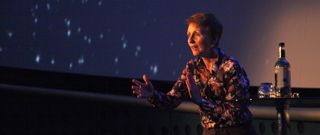
Helen Sharman – Britain’s First Astronaut
- 17th May 2017
- Author: Tamela Maciel
On 18 May 1991, a 27-year-old Brit from Sheffield sat on top of a Soviet Soyuz rocket in modern-day Kazakhstan, ready to launch into space. Her name was Helen Sharman. On that day she made history by becoming Britain’s first astronaut, pre-dating astronaut Tim Peake by 24 years.
Helen Sharman doesn’t fit the historical mould of a fighter-pilot-turned-astronaut, and wonderfully so. She grew up in Sheffield and studied chemistry at Birkbeck College, London. In 1987 she became a food chemist for Mars Wrigley Confectionery in Slough where she worked on the chemistry of ice cream and chocolate! Not a bad job, but in 1989 when Helen chanced to hear a job advert on the radio saying “astronaut wanted: no experience necessary” she immediately applied.
The space mission, called Project Juno, was a unique collaboration between the Soviet Union and private British companies. The goal was to foster UK-Soviet relations by flying a British astronaut on the Mir space station.
Despite the simple advert, the selection process for a Project Juno astronaut wasn’t a mere lottery. Helen’s scientific background, her aptitude for foreign languages, and her high level of fitness helped her beat nearly 13,000 other applicants. She was selected as one of only two candidates to undertake the full-time astronaut training at Star City near Moscow.
After a rigorous 18 months of training, Helen launched on 18 May 1991 and spent eight days on the Mir space station. While in space, she ran various biological experiments and investigated crystal growth in microgravity as well as chatted with British school children over amateur radio. And, like Tim Peake did 24 years later, Helen also carried some seeds into space for comparison with Earth-based seeds in British schools.
Until Tim Peake launched in 2015, Helen was the only British astronaut to fly under the UK flag. Other Brits, such as Michael Foale and Piers Sellers, have flown as NASA astronauts because they held dual US-UK citizenship.
Helen will always hold a special place in British spaceflight history. Here at the National Space Centre we are honoured to look after some of Helen’s personal effects from her mission.
One of the crown jewel artefacts at the National Space Centre is Helen’s launch couch, which she sat in during her Soyuz trip to and from the Mir space station. This Kazbek-UM Shock Absorbing Couch has actually flown in space four times on different missions, making it one of the most space-flown artefacts at the National Space Centre. Helen’s couch is custom-lined for her body to prevent injury from the strong forces in launch and landing. It’s displayed along with Helen’s training Sokol KV-2 Rescue Spacesuit to give a sense of just how cramped the couch can be.
On display you can also find Helen’s PK-14 Cosmonaut Flightsuit, which she wore during her eight days on Mir. If you look carefully, you can see a small brown stain on the right-hand chest of the blue suit from when Helen spilled some hot chocolate – easy to do in the microgravity of space! The jacket was rarely worn, as it was usually too hot.
Finally, you can check out Helen’s Mir hygiene kit containing the toothpicks, comb, hairbrush and nail file that she used in space.
Find these artefacts and more from Helen Sharman’s mission in the Into Space gallery at the National Space Centre.
Today Helen is the UK Outreach Ambassador at Imperial College London, and has received honorary doctorate degrees from several universities. She is an avid champion of human spaceflight and the need for the UK to stay involved.
She’ll be delighted, no doubt, that the UK recently recommitted itself to the European Space Agency’s human spaceflight programme, paving the way for a future British astronaut to follow in her footsteps.
As Helen said on the 25th anniversary of her mission, “We will have to work more closely together than ever before if we are to succeed in the next generation of space exploration. The next great objective is the one that Soviet’s dreamt about at the very start of human spaceflight with Gagarin’s launch in 1961: Mars. Would I like to join them in a mission to the red planet? If I knew I could return, I would do it in an instant.”
Enjoy this beautiful montage of Helen Sharman’s mission, put together by the Science Museum on the 25th anniversary of her flight in 2016.
About the author: Dr Tamela Maciel is the Space Communications Manager at the National Space Centre.
Full Credits / References
(Banner image) Helen Sharman presenting in the National Space Centre's planetarium. Credit: National Space Centre
(1) Helen Sharman's astronaut portrait. Credit: ESA
(2a) The Kazbek-UM Shock Absorbing Couch Helen Sharman used. Credit: National Space Centre
(2b) The PK-14 Cosmonaut Flightsuit worn by Helen Sharman. Credit: National Space Centre
(2c) Helen Sharman's Mir hygiene kit. Credit: National Space Centre
(3) Helen Sharman in 2015. Credit: Anne-Katrin Purkiss, CC BY-SA 4.0
(video) Who was the first Briton in space? Credit: Science Museum






